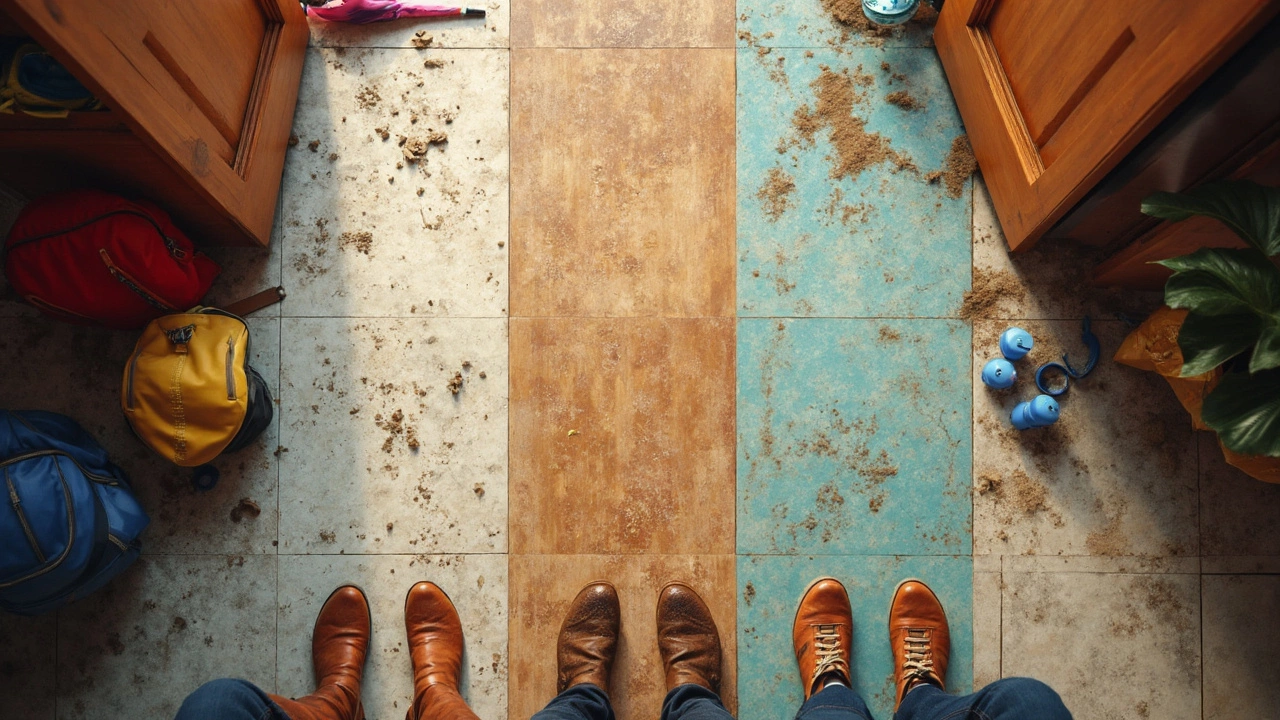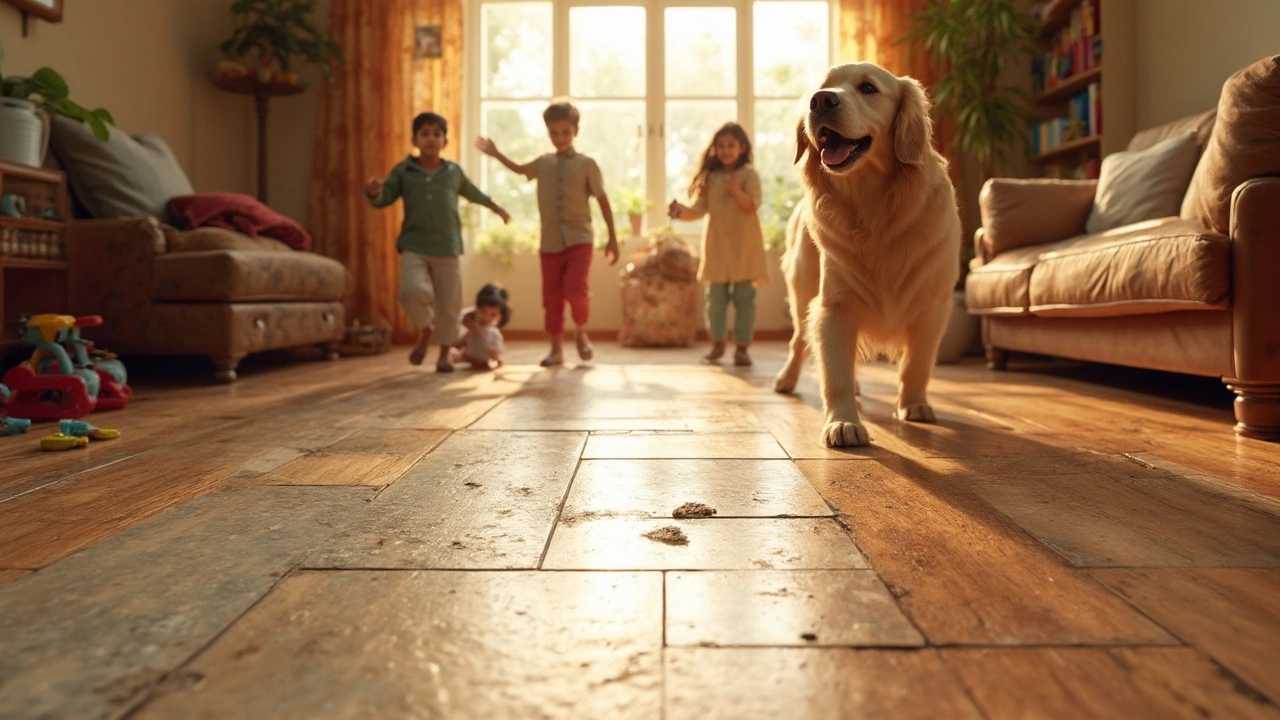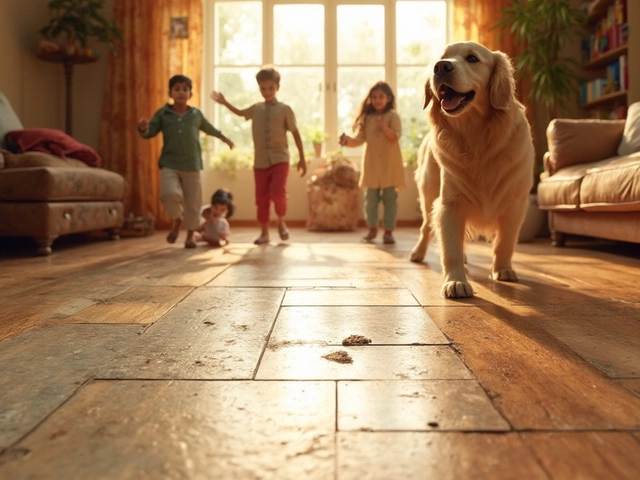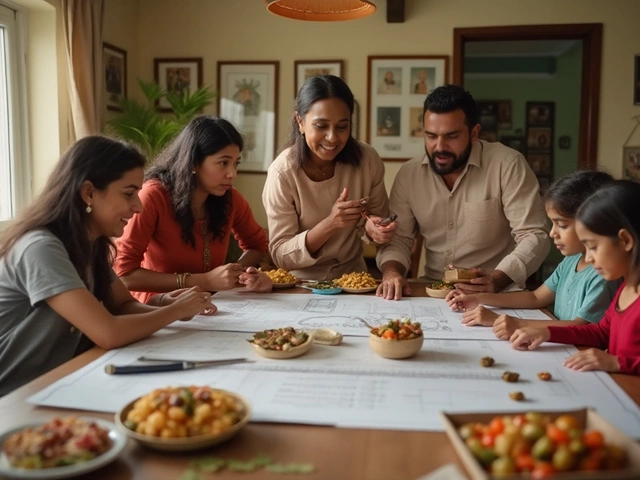Imagine dropping a bowling ball on your floor. Or having your dog sprint laps during a thunderstorm. Not every floor is built for chaos, but if you want something that shrugs it all off, the choice is clearer than you think.
When people talk about long-lasting flooring, they're usually thinking about more than just looks—they want stuff that holds up to spills, scratches, and the kind of wear that happens when life gets messy. The usual suspects? Tile, hardwood, vinyl, laminate, and even concrete. Each has its strong points, but only a couple really play the long game.
Most folks are surprised to hear that tile is almost legendary for its lifespan. There are homes in Europe with tile floors that have seen a hundred years of dinner parties and muddy boots. Hardwood is no slouch either—if you’re cool with refinishing every so often.
But here’s the tip no one talks about: Your own habits matter just as much as the material. If you drag furniture or forget about moisture, even “indestructible” floors can take a beating. It’s not all about picking the toughest stuff—it’s also about how you treat it.
- Real-World Wear: Which Flooring Toughs It Out?
- Breaking Down the Top Contenders: Pros and Cons
- Care Hacks to Make Any Floor Last Longer
- How to Pick What’s Best for Your Home and Life
Real-World Wear: Which Flooring Toughs It Out?
Let’s get real—floors take a pounding. Between muddy shoes, dropped dishes, wild pets, and daily shuffling, not all surfaces survive for the long haul. If you’re hunting for the longest lasting flooring, here’s what actually stands the test of time.
Porcelain and ceramic tile are absolute tanks. Good-quality tile can last over 50 years if installed right, and some have stayed put for centuries in old-world homes. They’re super-resistant to water, stains, and even claws from a dog like Max who thinks the living room is a racetrack. The only way to really mess up tile is to drop something incredibly heavy right on a corner, or ignore cracks in the grout for years.
Solid hardwood is another contender. If you pick a dense wood like oak or maple, and you’re alright sanding and refinishing every so often, hardwood can wear in—rather than wear out—for decades. It does scratch, though, and standing water is its sworn enemy. But hey, there are 100-year-old hardwood floors in old houses still going strong.
Luxury vinyl plank (LVP) isn’t invincible, but the new stuff lasts much longer than grandma’s vinyl squares. Some brands guarantee 20–30 years of use, and they’re tough against spills, scratches, and rowdy kids. Plus, they’re easier on your feet than tile or concrete.
Concrete floors take durability up a notch, especially for basements or modern homes. They won’t scratch or dent, but they’ll really hurt your toes if you drop something, and they’re cold unless you heat them up somehow.
Laminates, especially those designed for commercial use, can last 15–25 years with the right care. They’re resistant to scratches and stains, but they don’t handle water very well, so kitchens and bathrooms are risky.
- If you’ve got high foot traffic, messy family life, or pets with way too much energy, tile or LVP are your safest bets.
- Want something classic that can be spruced up every few decades? Go hardwood, but baby it a little.
- Budget is a factor? Good-quality laminate gives you a decent shot at long life if you keep it dry.
Bottom line: Pick the surface based on your home’s chaos level and how much attention you want to give it over the years.
Breaking Down the Top Contenders: Pros and Cons
Choosing the longest lasting flooring usually means you’re lining up tile, hardwood, vinyl, laminate, and, for the serious crowd, concrete. Each one brings plenty to the table, but not all of them make sense for every room or budget. Here’s how they really stack up.
- Tile (Ceramic or Porcelain): Tile is the rock star of durability. Porcelain, in particular, is dense, water-resistant, and tough enough that you’ll often find it in airports. Tile barely blinks at scratches, and it laughs at spills. If you drop a cast iron pan, the tile may chip, but good luck wearing it out with foot traffic. Grout does need resealing every couple of years, though. Tile feels cold and hard underfoot, so it’s not everyone’s favorite in bedrooms or living rooms.
- Hardwood: Real hardwood is classic and, with a little care, will last decades. What most people miss: these floors can be sanded and refinished multiple times, literally erasing years of dents and dings. It’s not a fan of standing water, so skip it in bathrooms. If you have big dogs with sharp nails (Max, I’m looking at you), expect some scratches – but those can be fixed too.
- Luxury Vinyl: Modern vinyl planks fool a ton of people because they look like wood or stone but act like armor. They’re waterproof, easy to clean, and can take a beating without showing it. Most options will come with a strong warranty—some up to 25 years—but not all are created equal. Go cheap, and you’ll see cracks or curling within a few years.
- Laminate: Laminate used to have a bad rap, but new high-quality products are pretty tough. Easy to install, affordable, and built for busy spaces. Its Achilles’ heel? Water. Even the "water-resistant" kind can swell if moisture sneaks in the seams.
- Concrete: Industrial, simple, and basically forever if sealed right. Not everyone loves the look, and it can be chilly on bare feet. But for long-lasting, it’s hard to get better—think warehouses, garages, or super-modern homes.
| Flooring Type | Lifespan (Years) | Best For | Weakness |
|---|---|---|---|
| Porcelain Tile | 50+ | Kitchens, baths, entryways | Cold, grout maintenance |
| Solid Hardwood | 30–100 | Living rooms, bedrooms | Water, scratching |
| Luxury Vinyl | 20–25 | Basements, kitchens, busy homes | Cheap versions crack, lower resale value |
| Laminate | 15–25 | Playrooms, rentals, moderate traffic | Moisture, not easily repairable |
| Concrete | 50+ | Garages, modern interiors, patios | Hard, cold |
Nobody wants a floor that’ll look rough after five years. Think about your deal-breakers first—is it moisture, mess, pets? Then lean toward the stuff built to laugh in the face of those daily battles. Cost, comfort, and look all matter, but if you want something near bombproof, focus on tile, properly installed vinyl, or even concrete. Save the fancy hardwood for where you want to show off, and use the workhorses for the places that see nonstop action.

Care Hacks to Make Any Floor Last Longer
If you want floors that keep looking good year after year, you’ve got to put in some care—no matter what type you install. A little effort goes a long way to stop scratches, stains, and major repairs down the road. Here’s the lowdown:
- Use rugs and mats at entryways. You’d be shocked how much grit, dirt, and sand walks in on shoes (or paws). Mats trap that junk before it chews up your floor’s surface.
- Don’t let water sit. Mop spills quick, especially on hardwood and laminate. Even tile grout hates staying wet for long; that’s how mold sneaks in.
- Furniture pads are a must. Chairs, tables, even pet bowls—put felt or rubber under anything that moves or scrapes.
- Vacuum or sweep at least once a week. Even tiny crumbs have sharp edges that can scratch, especially on shiny finishes.
- Stick to the right cleaners. No bleach on hardwood. No wax on vinyl. And don’t just go by the front label—check what’s actually in your cleaner first.
- Refinish or reseal when it’s time. Hardwood might need sanding every 7-10 years. Tile grout should get resealed every other year if you don’t want stains.
People love facts, so here’s one: According to a major flooring retailer, up to 80% of surface scratches come from stuff dragged in on shoes, not from wild kids or pets. Pretty wild, right?
A quick look at how much extra life you can get from smart maintenance:
| Floor Type | Average Lifespan (No Maintenance) | With Basic Care |
|---|---|---|
| Tile | 30 years | Over 50 years |
| Hardwood | 25 years | 40+ years |
| Vinyl | 10 years | 20 years |
| Laminate | 8 years | 15 years |
If you remember just one thing, let it be this: Regular, low-key upkeep does more for longest lasting flooring than any fancy product or “guaranteed” finish ever could.
How to Pick What’s Best for Your Home and Life
You want flooring that looks sharp, but let’s be real: your life doesn’t happen in a magazine. So before you get sold on whatever’s trending, stop and look at how your house actually runs day to day.
Do you have kids who forget to wipe their feet? Pets like my dog Max who sees mud as a personal invitation? Or are you way more likely to spill coffee while rushing out in the morning? These things all matter for choosing longest lasting flooring — and dodging headaches down the road.
Here’s what to really think about:
- Traffic: Entryways and kitchens get hammered most. Tile and luxury vinyl planks (LVP) laugh off foot traffic and dropped groceries. Hardwood looks great but scuffs easier unless you go for the harder species, like hickory or maple.
- Water Woes: Bathrooms and basements are rough on most floors. Porcelain tile is basically waterproof. Vinyl planks can also handle puddles — a lifesaver with kids or wet dogs. Hardwood and some laminates will swell or warp if you’re not on top of mop-ups.
- Allergies: Carpeting is comfy, but it traps dust. Hard surfaces like tile, vinyl, or sealed hardwood are way easier to keep clean if someone in the family has allergies.
- Budget: Tile and hardwood are more up front. LVP and good laminates can mimic the look for less, and last surprisingly long thanks to new top layers that fight scratches and dents.
If you want a shortcut, jot down answers to these:
- Does anyone in your home have allergies or breathing issues?
- How much mess do you make (really)? Pets, kids, shoes in the house?
- How much DIY maintenance are you cool with — sweeping/vacuuming, mopping, resealing every few years?
- What’s realistic for your renovation budget?
Don't let the sales pitch decide for you — let your daily routine lead the way. The best floor is the one that keeps up with your life and still looks good years later. It’s not always the most expensive or flashiest floor, but it sure is the one you don’t curse at every time Max tracks in mud.


